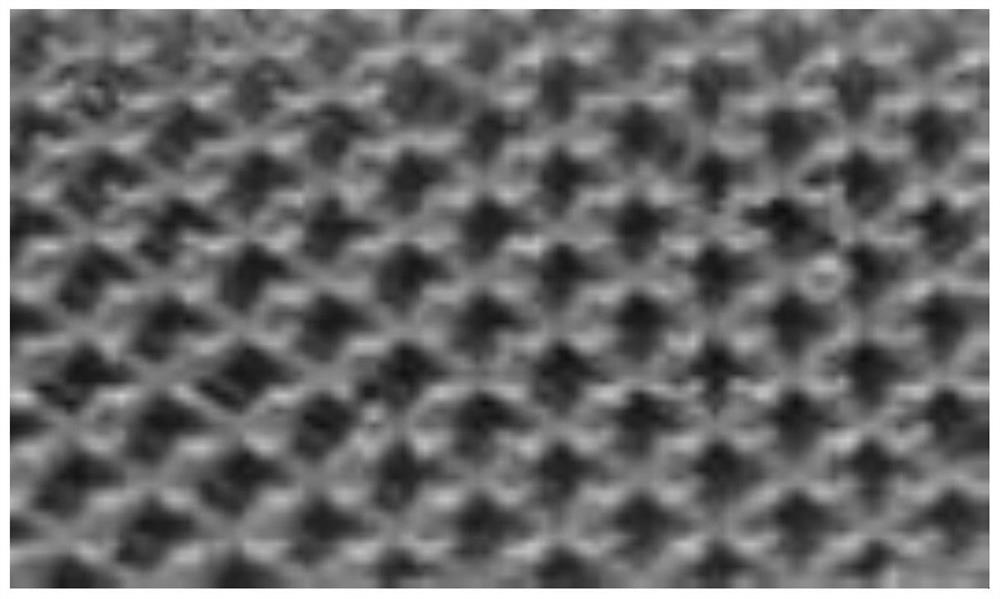Digital customization method of orthopedic implant material
A technology for implant materials and bone materials, which is applied in the field of material preparation, can solve problems such as lack of antibacterial properties, poor biological activity, and increased difficulty in processing and manufacturing, and achieve good application prospects, good pore characteristics, and good biocompatibility.
- Summary
- Abstract
- Description
- Claims
- Application Information
AI Technical Summary
Problems solved by technology
Method used
Image
Examples
Embodiment 1
[0020] A method for digitally customizing orthopedic implant materials, specifically comprising the following steps:
[0021] (1) Apply thin-section CT technology and Mimics software to establish a three-dimensional spatial structure model of the bone material required for the patient's bone defect; perform data processing on the three-dimensional model to make the shape of the three-dimensional spatial structure model consistent with the required bone material, with a grid in the middle Like structure, the side length of each unit body in the grid-like structure is 2mm.
[0022] (2) Import the processed three-dimensional model data into a metal 3D printer, and print to obtain a spatial structure reinforcement. The spatial structure reinforcement is obtained by 3D printing using a mixed powder of Ti, Nb, and Zr as a raw material. The mixed powder is denoted as A, the mass percentage of each element in the mixed powder A is Nb 20%, Zr 18%, and the balance is Ti, and the particl...
Embodiment 2
[0028] A method for digitally customizing orthopedic implant materials, specifically comprising the following steps:
[0029] (1) Apply thin-section CT technology and Mimics software to establish a three-dimensional spatial structure model of the bone material required for the patient's bone defect; perform data processing on the three-dimensional model to make the shape of the three-dimensional spatial structure model consistent with the required bone material, with a grid in the middle Like structure, the side length of each unit body in the grid-like structure is 3mm.
[0030] (2) Import the processed three-dimensional model data into a metal 3D printer, and print to obtain a spatial structure reinforcement. The spatial structure reinforcement is obtained by 3D printing using a mixed powder of Ti, Nb, and Zr as a raw material. The mixed powder is denoted as A, the mass percentage of each element in the mixed powder A is Nb 19%, Zr 15%, and the balance is Ti, and the particl...
Embodiment 3
[0036] A method for digitally customizing orthopedic implant materials, specifically comprising the following steps:
[0037] (1) Apply thin-section CT technology and Mimics software to establish a three-dimensional spatial structure model of the bone material required for the patient's bone defect; perform data processing on the three-dimensional model to make the shape of the three-dimensional spatial structure model consistent with the required bone material, with a grid in the middle Like structure, the side length of each unit body in the grid-like structure is 2mm.
[0038] (2) Import the processed three-dimensional model data into a metal 3D printer, and print to obtain a spatial structure reinforcement. The spatial structure reinforcement is obtained by 3D printing using a mixed powder of Ti, Nb, and Zr as a raw material. The mixed powder is denoted as A, the mass percentage of each element in the mixed powder A is Nb 18%, Zr 17%, and the balance is Ti, and the particl...
PUM
| Property | Measurement | Unit |
|---|---|---|
| Compressive strength | aaaaa | aaaaa |
| Elastic modulus | aaaaa | aaaaa |
| Compressive strength | aaaaa | aaaaa |
Abstract
Description
Claims
Application Information
 Login to View More
Login to View More - R&D
- Intellectual Property
- Life Sciences
- Materials
- Tech Scout
- Unparalleled Data Quality
- Higher Quality Content
- 60% Fewer Hallucinations
Browse by: Latest US Patents, China's latest patents, Technical Efficacy Thesaurus, Application Domain, Technology Topic, Popular Technical Reports.
© 2025 PatSnap. All rights reserved.Legal|Privacy policy|Modern Slavery Act Transparency Statement|Sitemap|About US| Contact US: help@patsnap.com

